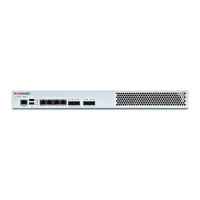Configuring Network Interface (Network Setting) How to set up your FortiWAN
As described, FortiWAN Port 1 is connected to VLAN switch, and an appropriate VLAN setting is complete on the
VLAN switch. Now VLAN tagging is required on FortiWAN. The steps are:
1.
In the VLAN and Port Mapping table, click the Add button in the VLAN Tag column for Port 1 to add a VLAN Tag
editor (The string "no VLAN Tag" will become blank and be editable, Delete, Move Up and Move Down buttons
appears also).
2.
Enter the correct VLAN Tag.
3.
Specify this VLAN with a port mapping (WAN, LAN or DMZ) in Mapping column.
4.
Click the Add button to add and edit the next VLAN.
Port VLAN Tag Mapping
Port 1 101 WAN
102 WAN
103 LAN
104 DMZ
After this configuration, FortiWAN's port 1 will no longer accept untagged VLAN packets. Port 1.101 and port 1.102 on
VLAN Switch are directly connected with WAN links (Port 1.101 and Port 1.102 are listed in the WAN Port pull-
down menu for WAN Setting), while port 1.103 is connected with PCs in LAN (Port 1.103 is listed in the LAN
Port pull-down menu for Private LAN Subnet setting) and port 1.104 is connected with PCs in DMZ (Port 1.104
is listed in the DMZ Port pull-down menu for WAN Setting). In this network, FortiWAN acts as the role of
router. PCs in DMZ can be assigned with public IP addresses, with their packets transparently passing through
FortiWAN to WAN. Apart from FortiWAN ports, it is necessary to configure VLAN Switch as well, like the settings of
tags and IP addresses.
Note: This field (VRID) is only available when VRRP mode is enabled in LAN Private Subnet settings. The VRID
indicates the virtual router identifier for every VR.
FortiWAN Handbook
Fortinet Technologies Inc.
51

